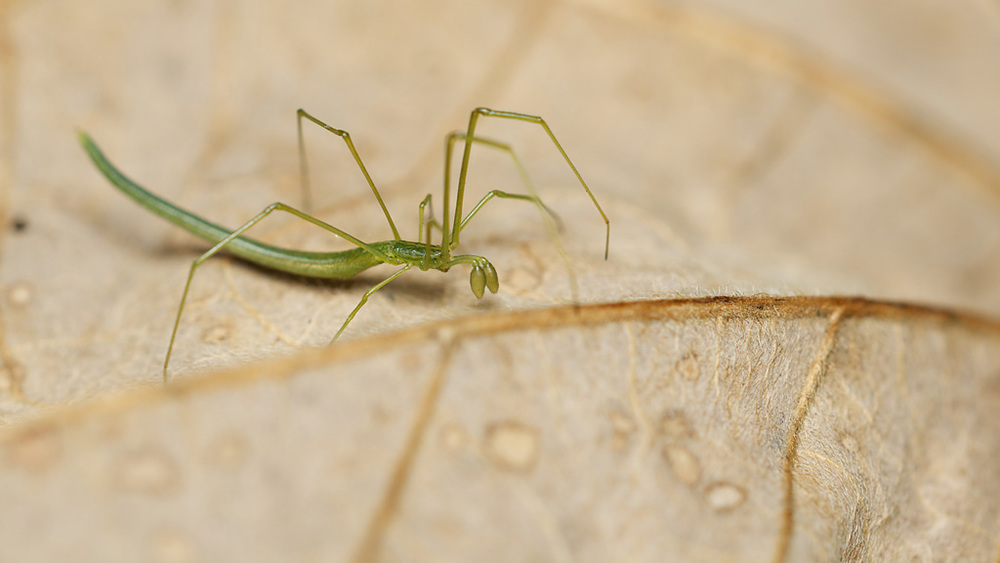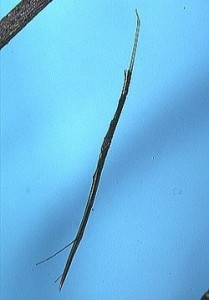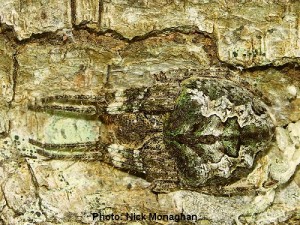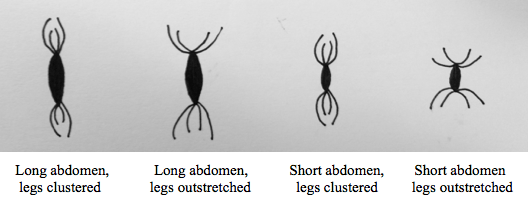
Ariamnes cylindrogaster may not be cute, but he’s a master of disguise. (source)

Ariamnes cylindrogaster making like a twig in crypsis. (source)
Have you ever seen someone you’d rather not run into and wish you could just fade into the background? Well, Ariamnes cylindrogaster, a spider native to Japan, Korea, and China, can! You’ve probably heard of camouflage, an adaptation that allows animals to blend in with their environment. You’ve also probably heard of masquerading, but maybe not as it applies to stick bugs, fish, and many other animals. Masquerade is a type of camouflage in which an organism avoids the attention of predators by looking like an inanimate object. For example, crab spiders mimic bird droppings, which certainly wouldn’t be appetizing to a bird looking for a meal!
Ariamnes cylindrogaster engage in a type of masquerading called twig-mimicking, and it’s exactly what it sounds like: they blend in by looking like a twig. This has two elements: contour modification and coloration. Contour modification refers to holding some sort of pose to look less like a spider. In this case, Ariamnes cylindrogaster stretches out their front and back legs, presumably to look like a twig, in a posture known as crypsis.

Other spiders also use crypsis to blend in. This garden orb-weaver camouflages to treebark. (source)
Scientists hypothesized that crypsis really was causing wasps, the main predator of these spiders, to ignore them. Coloration isn’t thought to be a large factor of their camouflage, because they don’t match the area exactly, and aren’t directly up against a background like the forest floor. This is because they spend their days stretched on a single thread of silk, suspended away from trees and leaves. To test which posture was approached the least, they made four types of dummies, as shown below. They modified abdomen length to test whether or not it was an important part of crypsis, and leg position to compare in-pose versus out of pose spiders. The models were made of paper in shades determined using the visible spectrum of bees, which are another predator of the spiders and closely related to wasps. Once they had made their dummy spiders, they went into the natural habitat of Ariamnes cylindrogaster and collected single threads of giant wood spider silk to suspend the dummies from. Finally, they set up video cameras and waited to observe the wasps’ reactions.

Representations of the four model spider positions created for the study. (source: M. Hickman, 2015)
They found that both types of models with clustered legs were less often approached, regardless of abdomen length. This strongly suggests that crypsis is an important posture for predator avoidance, and mostly involves moving the legs in line with the body. They may not be mimicking twigs, however. Researchers are unsure if the position is effective because of it’s twig-like appearance, which seems unlikely because the spiders suspend themselves away from trees, or due to wasps and bees natural difficulty perceiving linear objects. Either way, these spiders have found a way to avoid notice when it matters, meaning they can stick around for a while more.
Zhang, S., Mao, K., Lin, P., Ho, C., Hung, W., Piorkowski, D., Liao, C., Tso, I. (2015). Crypsis via leg clustering: twig masquerading in a spider. R. Soc. open sci. (2)150007. 1-7.
